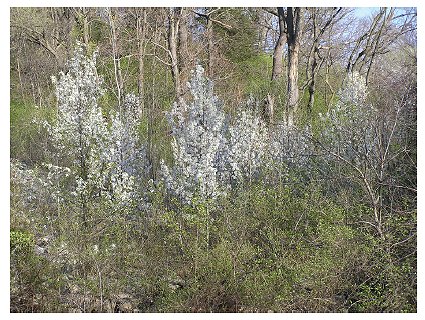AgEBB-MU CAFNR Extension
Green Horizons
Volume 20, Number 2
May 2016
Urban Forestry
Bradford Pear: Beautiful Flowers, Few Pests, Grows Anywhere...
What Could Go Wrong
By ANASTASIA BECKER | Missouri Dept. of Agriculture
Ornamental pears (Bradford' and other cultivars) had an extended bloom period this spring due to the weather. It was very obvious that many trees have escaped cultivation and have been thriving in open, disturbed habitats, especially in urban areas. What happened? Weren't these ornamental pears supposed to be sterile cultivars?
It is a tale of unintended consequences, starting in the early 1900s with the introduction of fire blight-resistant Callery pear from China as rootstock in breeding programs for common pear. At the time, common pear yields were down by more than 80% due to fire blight. Using resistant Chinese Callery pear rootstock gave our common pear crop much needed protection. Then, in 1952, a particularly vigorous, thornless Callery pear with abundant flowers was observed in an experimental breeding field. The tree was propagated with cuttings and tested as an ornamental street tree. The cultivar was named 'Bradford' and the rest is horticultural history.
Since the early 1960s, the Bradford pear cultivar has become one of the most widely planted trees in urban landscapes because it tolerates diverse environmental conditions, is relatively pest free, grows rapidly and flowers profusely, yet rarely produces fruit since it can't self-pollinate. Its major drawback is weak branch crotches which make it prone to splitting in storms. This led to the development of other cultivars with better branching, fall color and disease resistance. All of the ornamental pear cultivars are self-incompatible, meaning they can't produce seed with self-pollination, so they were considered to have little potential to become invasive.
 |
Bradford pears that that have escaped from a yard and are thriving in a disturbed habitat. Photo credit: Anastasia Becker |
However, a perfect storm developed and in recent years, abundant fruits have been found on many cultivars grown in urban settings. The theory on why fruits with viable seeds are now being produced can be traced back to genetics. All of the ornamental pear cultivars are grafted or budded onto rootstock of the Chinese Callery pear. While each cultivar is self-incompatible, cross pollination can occur between different cultivars in close proximity or if sprouts from the rootstock flower, since they differ genetically from the grafted scion. This results in the formation of larger fruits with viable seeds. Birds, especially starlings, took advantage of this new food source and naturally deposited the seeds.
When these seeds sprout, these wild, naturalized plants tend to have the upright form and many develop thorns on branch ends like the original Callery pears used in earlier breeding efforts. Some of the traits that make ornamental pear desirable in our landscapes (rapid growth, abundant flowers, few pests and highly adaptable to various conditions) are the same characteristics that make these trees invasive when they escape cultivation. Once established, these wild Callery pears can form a sizeable patch in several years that competes with native early succession trees in hedgerows, forest edges and old fields. Currently, wild Callery pear has been found in natural areas in more than 25 states.
What can be done if you have a patch of these undesirable trees? Seedlings and shallow-rooted trees can be pulled if the soil is moist. Trees can be cut and systemic herbicide applied immediately to the stump to prevent sprouting. Basal bark treatment is another option and is faster than cutting and treating. For larger trees, girdle them in spring and summer and consider applying an appropriate herbicide immediately to the girdled area. Optimal times for herbicide uptake are late winter to early spring, or during the summer. For specifics, consult Missouri Department of Conservation's Callery Pear publication, which is part of their invasive species series. Repeated treatments will be needed for several years since trees can resprout and there is a seed bank in the soil.
Instead of planting more ornamental pears in our landscapes, consider instead some of the attractive alternative native trees such as American plum, Mexican plum, flowering dogwood (our state tree), eastern redbud, green hawthorn (almost thornless and resists cedar rust diseases), American smoke tree, Carolina buckthorn, rusty (southern) black haw and serviceberry.
Link for the MDC Callery Pear pub: http://mdc.mo.gov/sites/default/files/resources/2012/05/callerypearinvasive.pdf
If interested in an in-depth read check out The Beginning of a New Invasive Plant: A History of the Ornamental Callery Pear in the United States by Theresa Culley and Nicole Hardiman, BioScience, Dec. 2007, Vol. 57 No. 11
